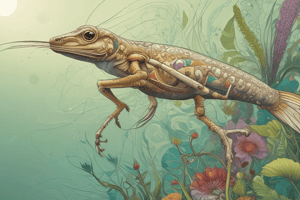Podcast
Questions and Answers
Symbiosis involves organisms in mutually beneficial relationships only, known as mutualism.
Symbiosis involves organisms in mutually beneficial relationships only, known as mutualism.
False (B)
Photosynthesis occurs in the mitochondria of plant cells.
Photosynthesis occurs in the mitochondria of plant cells.
False (B)
The Krebs Cycle produces carbon dioxide and is part of the cellular respiration process.
The Krebs Cycle produces carbon dioxide and is part of the cellular respiration process.
True (A)
In a food web, energy transfers from one trophic level to the next at approximately 50%.
In a food web, energy transfers from one trophic level to the next at approximately 50%.
Autotrophs can create their own food through processes like photosynthesis.
Autotrophs can create their own food through processes like photosynthesis.
The nitrogen cycle includes a process called erosion of rocks for nutrient absorption.
The nitrogen cycle includes a process called erosion of rocks for nutrient absorption.
Exergonic reactions are those that require energy in the form of ATP to proceed.
Exergonic reactions are those that require energy in the form of ATP to proceed.
Mass in organisms primarily comes from carbon absorbed during photosynthesis.
Mass in organisms primarily comes from carbon absorbed during photosynthesis.
Flashcards
Scientific Method
Scientific Method
A systematic process used in science to investigate phenomena, ensuring repeatable and reliable results. It involves observation, questioning, hypothesis formulation, experimentation, data analysis, and conclusion drawing.
What are the characteristics of life?
What are the characteristics of life?
Living organisms share seven key traits: being made of cells, obtaining and using energy, growing and developing, reproducing, responding to stimuli, maintaining homeostasis, and adapting/evolving over time.
Symbiosis
Symbiosis
A close and long-term interaction between two different species. It can be mutualistic (+/+), where both benefit; commensalistic (+/0), where one benefits while the other is unaffected; or parasitic (+/-), where one benefits at the expense of the other.
Cellular Respiration
Cellular Respiration
Signup and view all the flashcards
Photosynthesis
Photosynthesis
Signup and view all the flashcards
Autotrophs
Autotrophs
Signup and view all the flashcards
Exergonic Reactions
Exergonic Reactions
Signup and view all the flashcards
Where does the mass of organisms come from?
Where does the mass of organisms come from?
Signup and view all the flashcards
Study Notes
Part 1: Ecology and Basics of Life
-
Scientific Method: Follows steps: Observation, Question, Hypothesis, Experiment, Analyze, Conclusion. Crucial for reliable scientific results.
-
Characteristics of Life: Living things share these traits:
- Made of cells
- Obtain/use energy
- Grow and develop
- Reproduce
- Respond to stimuli
- Maintain homeostasis
- Adapt/evolve over time
-
Organism Interactions:
- Symbiosis: Mutualism (+/+), Commensalism (+/0), Parasitism (+/-)
- Predator-Prey: Maintain ecosystem balance.
- Competition: Struggle for limited resources.
- Cooperation: Collaboration for survival.
-
Food Webs & Trophic Levels:
- Producers → Primary Consumers → Secondary Consumers → Tertiary Consumers → Decomposers
- Energy Transfer: Approximately 10% energy moves to the next level.
- Food Web: A visual representation of interconnected feeding relationships.
-
Biogeochemical Cycles:
- Water Cycle: Evaporation → Condensation → Precipitation → Runoff/Infiltration
- Carbon Cycle: Photosynthesis ↔ Respiration, Fossil fuels, Ocean absorption
- Nitrogen Cycle: Fixation → Nitrification → Uptake by plants
- Phosphorus Cycle: Erosion of rocks → Absorption by plants → Food chain
Part 2: Cellular Energy and Biochemistry
-
Cellular Respiration:
- Breaks down glucose to create ATP (energy).
- Glycolysis: In cytoplasm. Glucose → 2 Pyruvate + 2 ATP
- Krebs Cycle: In mitochondria. Produces CO₂ and energy carriers (NADH, FADH₂).
- Electron Transport Chain: In mitochondria. Uses oxygen to produce ~34 ATP.
-
Photosynthesis:
- Converts light energy into glucose.
- Light-Dependent Reactions: In thylakoids. Uses sunlight to create ATP and NADPH. Photosystem II → Electron Transport → Photosystem I
- Calvin Cycle: In stroma. Uses ATP, NADPH, and CO₂ to produce glucose.
-
How Organisms Get Energy:
- Autotrophs: Make their own food (e.g., plants via photosynthesis).
- Heterotrophs: Consume other organisms for energy.
- Chemosynthesis: Bacteria use inorganic chemicals to produce energy.
-
Chemical Reactions & Energy:
- Exergonic: Release energy (e.g., cellular respiration).
- Endergonic: Require energy (e.g., photosynthesis).
- Calories/Kilocalories: Unit of energy measurement. 1 kilocalorie = 1000 calories.
-
Mass of Organisms:
- Primarily derived from carbon (absorbed as CO₂ in photosynthesis).
- Atoms bond to form molecules (carbs, lipids, proteins).
- Growth reflects the build-up of these molecules in cells.
Studying That Suits You
Use AI to generate personalized quizzes and flashcards to suit your learning preferences.




